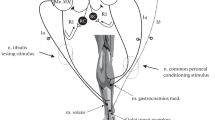Summary
Dorsal column stimulation in two spastic patients with upper motor neurone disease showed the following effects:
-
1.
The subjective feeling of stiffness decreased. During DCS patients were able to walk longer distances without rest.
-
2.
The ability to perform fast alternating or synchronous “pedal-pressing” foot movements improved by 15%.
-
3.
The threshold of H-reflexes was enhanced up to 12%, and outlasted the end of stimulation by two minutes.
-
4.
The H-reflex amplitude was depressed in relation to intensity and duration of DC-stimulation up to 10 minutes after the end of DCS.
-
5.
A late second facilitatory wave at 300 msec in the curve for H-reflexes conditioned by a short tibial stimulus was inhibited during DCS.
Although the hyperexcitability of the H-reflex was dampened significantly during DCS the whole motor disturbance improved only slightly.
Similar content being viewed by others
References
Bantli, H., Bloedel, J. R., Long, D. M., Thienprasit, Ph., Distribution of activity in spinal pathways evoked by experimental dorsal column stimulation. J. Neurosurg.42 (1975), 290–295.
Krainick, J.-U., Thoden, U., Methoden der elektrischen Schmerzunterdrückung. Langenbeck's Archiv für Chirurgie342 (1976), 75–81.
— —, Riechert, T., Teuschert, G., Elektrische Hinterstrangreizung bei chronischen Schmerzen. Neurochirurgica17 (1974), 162–170.
— — —, Spinal cord stimulation in post amputation pain. Surg. neurol.4 (1975), 167–170.
Lindblom, U., Meyerson, B. A., Influence on touch, vibration and cutaneous pain of dorsal column stimulation in man. Pain1 (1975), 257–270.
Melzack, R., Wall, P. D., Pain mechanisms: A new theory. Science150 (1965), 971–979.
Nashold, B. S., Friedman, H., Dorsal column stimulation for control of pain. Preliminary report on 30 patients. J. Neurosurg.36 (1972), 590–592.
Shealy, C. N., Mortimer, J. T., Hagfors, N. R., Dorsal column electroanalgesia. J. Neurosurg.32 (1970), 560–564.
Siegfried, J., Traitment neurochirurgical de quelques symptômes de la sclérose en plaque. Méd. et Hyg.34 (1976), 901–903.
Thoden, U., Krainick, J.-U., Straßburg, H. M., Wenzel, D., Modulation of monosynaptic reflexes by dorsal column stimulation (DCS) in spasticity. Pflüg. Arch.365 (1976), R 41.
Zimmermann, M., Neurophysiology of Nociception. Int. Rev. of Physiol., Neurophysiol. II, Vol. 10, 179–221. Ed. R. Porter. Baltimore: Univ. Park Press.
Author information
Authors and Affiliations
Additional information
Supported by Sonderforschungsbereich Hirnforschung und Sinnesphysiologie (SFB 70) der Deutschen Forschungsgemeinschaft (DFG) and the Bundesminister für Arbeit und Sozialordnung Bonn-Bad Godesberg.
Rights and permissions
About this article
Cite this article
Thoden, U., Krainick, J.U., Straßburg, H.M. et al. Influence of dorsal column stimulation (DCS) on spastic movement disorders. Acta neurochir 39, 233–240 (1977). https://doi.org/10.1007/BF01406733
Issue Date:
DOI: https://doi.org/10.1007/BF01406733




